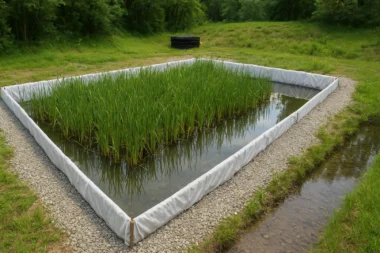Introduction
Modular water treatment systems are compact and scalable units designed to provide efficient and flexible solutions for water treatment in various applications. These systems consist of pre-engineered modules that can be easily transported, assembled, and integrated to meet specific water treatment needs. Here’s an introduction to how modular water treatment systems work:
- Modular Design and Configuration: Modular water treatment systems are designed with standardized modules that can be combined and configured based on the specific requirements of the water source and the desired treatment goals. Modules may include pre-filtration, chemical dosing, membrane filtration, disinfection, and control systems.
- Pre-Treatment: The first step in modular water treatment systems is often pre-treatment, where raw water undergoes initial processes to remove large particles, sediments, and debris. This can involve various methods such as screening, sedimentation, or filters to ensure the water is free from physical impurities.
- Chemical Treatment: Depending on the water quality and treatment objectives, chemical treatment may address specific issues. The chemical dosing modules in the modular system make it possible to add coagulants, flocculants, disinfectants, or pH adjusters in the right amounts to make the treatment process work as well as possible. This step aids in the removal of suspended particles, pathogens, and dissolved contaminants.
- Filtration: Modular water treatment systems often incorporate filtration units, such as media filters or membrane filtration technologies, to remove finer suspended particles, bacteria, viruses, and other contaminants. Media filters utilize different types of filtration media, such as sand, activated carbon, or multimedia, to physically trap and remove impurities. Membrane filtration units employ semipermeable membranes that act as barriers, allowing clean water to pass while rejecting contaminants based on size and molecular weight.
- Disinfection: Disinfection is crucial to eliminate any remaining pathogens and ensure the water is safe for consumption or specific applications. Modular systems may include disinfection units that use chlorination, ultraviolet (UV) irradiation, or advanced oxidation processes to destroy or deactivate microorganisms, viruses, and other harmful agents.
- Monitoring and Control: Modular water treatment systems incorporate monitoring and control mechanisms to ensure optimal performance and water quality. These systems can include sensors, meters, and automated control systems that monitor parameters like flow rate, pressure, turbidity, pH, and disinfection levels. Real-time data monitoring allows for adjustments and optimization of the treatment process as needed.
- Scalability and Flexibility: One of the critical advantages of modular water treatment systems is their scalability and flexibility. Additional modules can be easily added or removed based on changing water treatment requirements, allowing adjustments to treatment capacity, treatment processes, or specific treatment goals.
- Portability and Mobility: Modular water treatment systems are designed to be portable and mobile, allowing for rapid deployment and relocation. They are often housed in containerized units, skids, or trailers, enabling easy transportation and installation in remote or temporary locations.
Principles behind modular water treatment systems
The principles behind modular water treatment systems are rooted in flexibility, scalability, and ease of deployment. These systems are designed to meet specific water treatment needs by employing modular components that can be combined and configured in various ways. Here are the fundamental principles behind modular water treatment systems:
- Modular Design: Modular water treatment systems are built with standardized modules that can be easily interconnected and integrated. These modules are pre-engineered and manufactured off-site, ensuring consistent quality and efficient assembly. The modular design allows flexibility in selecting and combining different treatment processes depending on the water source and treatment goals.
- Scalability: Modular systems are designed to be scalable, meaning they can be expanded or downsized based on the required treatment capacity. Additional modules can be added as demand increases or removed when demand decreases. This scalability allows for efficient resource utilization and cost-effectiveness, ensuring the treatment system can adapt to changing needs over time.
- Portability and Mobility: Modular water treatment systems are designed to be portable and mobile, making them suitable for various applications, including remote areas, disaster-stricken regions, or temporary water treatment requirements. The components are often housed in containerized units or skids, enabling easy transportation and rapid deployment to the desired location.
- Flexibility in Treatment Processes: The modular design allows for flexibility in selecting and combining different treatment processes within the system. Various treatment modules, such as pre-filtration, chemical dosing, filtration, disinfection, monitoring, and control, can be included and configured based on the specific water quality characteristics and treatment objectives. This flexibility enables customization of the treatment process to address specific contaminants or meet regulatory standards.
- Ease of Integration: Modular systems are designed for easy integration with existing infrastructure or as standalone units. They can be seamlessly integrated into existing water treatment plants, expanding their capacity or improving efficiency. Additionally, they can serve as independent units, operating autonomously for standalone water treatment applications.
- Monitoring and Control: Modular water treatment systems incorporate advanced monitoring and control mechanisms to ensure optimal performance and water quality. These systems utilize sensors, meters, and automated control systems to monitor parameters such as flow rate, pressure, turbidity, pH, and disinfection levels. Real-time data monitoring allows for adjustments and optimization of the treatment process as needed.
The architecture of these systems is designed to be modular and easily expandable.
The architecture of modular water treatment systems is specifically designed to facilitate modularity and easy expandability. Here are the key architectural features that enable these systems to be modular and easily expandable:
- Standard Modules: Modular water treatment systems are built with standard modules as the fundamental building blocks. These modules are pre-designed and pre-engineered units that perform specific treatment functions, such as pre-filtration, chemical dosing, filtration, disinfection, and monitoring and control. Each module is self-contained and can be easily integrated into the overall system.
- Interconnectivity: The modules in a modular water treatment system are designed to be easily interconnected. This involves standardized connection points, such as flanges or quick-connect fittings, allowing seamless integration and fluid flow between modules. Interconnectivity ensures efficient transfer of water and treatment processes between the modules.
- Expandable Framework: The system architecture includes an expandable framework that allows for adding or removing modules as needed. This framework can be a skid-mounted structure or a containerized unit, providing a solid and portable platform for housing the modules. The framework is designed with future expansion in mind, accommodating additional modules without significant modifications.
- Flexible Piping and Wiring: Modular water treatment systems incorporate flexible piping and wiring systems to facilitate easy module integration and expansion. These systems often use flexible hoses, quick-connect couplings, and modular electrical connections, allowing for straightforward installation and reconfiguration of modules. This flexibility enables quick and efficient expansion or rearrangement of modules as treatment requirements change.
- Modular Control and Monitoring: The architecture includes a central control and monitoring system that can easily integrate with the modules. This control system monitors process parameters such as flow rates, pressures, and water quality parameters. It also enables remote operation and control of the modules, allowing seamless coordination and optimization of the treatment processes.
- Scalable Power and Utilities: Modular water treatment systems are designed to accommodate scalable power and utility requirements. The architecture includes provisions for power connections, such as electrical panels and distribution boards that can be easily expanded to meet the increasing power demands of additional modules. Similarly, requirements for water supply, drainage, and other utilities are designed to be scalable and adaptable to accommodate the expanding system.
- Plug-and-Play Capability: Modular water treatment systems are designed with plug-and-play capability, allowing for rapid installation and commissioning of new modules. The standardized modules can be easily connected to the system framework and integrated into the control system without complex modifications or custom engineering.
By incorporating these architectural features, modular water treatment systems can provide flexibility, scalability, and ease of expansion. The standardized modules, interconnectivity, expandable framework, flexible piping and wiring, modular control and monitoring systems, and scalable power and utilities all contribute to these systems’ modular and easily expandable nature. This enables efficient and cost-effective customization and expansion of water treatment capacity as needed.
Technologies used
Modular water treatment systems utilize various technologies to treat water and effectively address specific contaminants or treatment objectives. The technologies employed may vary based on the water source, quality, and treatment goals. Here are some standard technologies used in modular water treatment systems:
Filtration Technologies:
- Media Filtration: Media filters use materials like sand, activated carbon, or multimedia to physically trap and remove suspended particles, sediments, and some organic matter.
- Membrane filtration uses semipermeable membranes to separate contaminants based on size, molecular weight, and charge. Microfiltration, ultrafiltration, nanofiltration, and reverse osmosis are all examples of membrane filtration technologies. Membrane filtration effectively removes suspended particles, bacteria, viruses, dissolved salts, and other impurities.
Disinfection Technologies:
- Chlorination: Chlorine is commonly used as a disinfectant to kill or deactivate microorganisms and pathogens. It can be applied in various forms, such as chlorine gas, sodium hypochlorite, or calcium hypochlorite.
- UV Disinfection: Ultraviolet (UV) disinfection uses UV light to damage the genetic material of microorganisms, rendering them unable to replicate and causing their inactivation.
- Ozone Disinfection: Ozone is a powerful oxidant that destroys microorganisms, viruses, and organic compounds through oxidation reactions. Ozone is generated on-site and is a commonly used disinfectant in water treatment.
Chemical Treatment:
- Coagulation and flocculation: Coagulation involves adding chemicals, such as aluminum or iron salts, to destabilize and aggregate suspended particles. Flocculation promotes the formation of larger particles called flocs, which can be easily removed through sedimentation or filtration.
- pH Adjustment: Chemicals like acids or bases are used to adjust the pH of the water to the desired range for optimal treatment efficiency or to enhance the effectiveness of other treatment processes.
Adsorption:
- Activated Carbon Adsorption: Activated carbon is a highly porous material that can adsorb and remove organic compounds, chlorine, and specific contaminants from water. It is commonly used in modular systems for taste and odor control and removing certain organic pollutants.
- Advanced Oxidation Processes (AOP):
- AOPs use strong oxidizing agents like hydrogen peroxide or advanced oxidizing agents like hydroxyl radicals to break down organic pollutants, new contaminants, and hard-to-remove compounds through oxidation reactions.
Monitoring and Control:
- Sensor Technologies: Various sensors, such as flow meters, pressure sensors, turbidity sensors, and pH sensors, are employed to monitor critical parameters and water quality in real-time. This data is used for process control, optimization, and ensuring treatment effectiveness.
Pre-engineered modules
Pre-engineered modules in modular water treatment systems are designed to be easily transported, assembled, and integrated to meet specific water treatment needs. These modules are pre-designed units that perform particular treatment functions and can be combined in various configurations. Here’s an overview of the characteristics and benefits of pre-engineered modules:
- Standardization: Pre-engineered modules are manufactured to standardized specifications, ensuring consistent quality and performance. They are designed based on industry standards and best practices, considering various treatment processes and their integration requirements.
- Compact and Portable: The modules are typically packed and portable, allowing effortless transportation and installation. They are often designed to fit within standard shipping containers, skids, or trailers, facilitating efficient logistics and reducing installation time and costs.
- Self-contained Units: Each module is a self-contained unit that houses the necessary equipment, components, and systems required for a specific treatment process. This includes pumps, valves, filters, membranes, disinfection systems, instrumentation, and control systems. Depending on the treatment requirements, the modules are designed to operate independently or in combination with other modules.
- Ease of Integration: Pre-engineered modules are designed for easy integration into the water treatment system. They are equipped with standardized connection points, such as flanges, quick-connect fittings, or electrical connectors, facilitating seamless integration and fluid flow between modules. This simplifies the installation process and minimizes the need for custom engineering or modifications.
- Flexibility: The modular nature of the pre-engineered units allows for flexibility and configurability. Different modules can be selected and combined based on the specific water treatment needs, desired treatment processes, and goals. This flexibility enables customization and optimization of the treatment system for particular applications and water quality characteristics.
- Expandability and Scalability: The system’s modularity allows for easy expansion and scalability. Additional modules can be added to the system as water treatment demands increase, providing the flexibility to accommodate growing capacity requirements. This scalability ensures the treatment system can adapt to changing needs and future expansion without significant disruptions or extensive modifications.
- Rapid Deployment: Pre-engineered modules enable rapid deployment of water treatment systems. Since the modules are pre-designed and pre-manufactured, they can be readily available and quickly assembled on-site. This is particularly beneficial in emergencies, temporary installations, or remote locations where time is critical.
- Standardized Operation and Maintenance: Standardization of the modules simplifies the operation and maintenance of the water treatment system. Operators can familiarise themselves with the standardized modules, allowing for efficient operation, troubleshooting, and maintenance activities. Additionally, standardized spare parts and components are readily available, facilitating ease of maintenance and reducing downtime.
Algorithms used
- Process Optimisation Algorithms: These algorithms aim to optimize the treatment process by adjusting various parameters, such as chemical dosing rates, filtration rates, and disinfection levels, to achieve the desired water quality objectives. Optimization algorithms use mathematical models and techniques to find the optimal operating conditions that minimize energy consumption, maximize treatment efficiency, or meet specific regulatory requirements.
- Control Algorithms: Control algorithms monitor and control the operation of different components and processes within the water treatment system. These algorithms receive input from sensors and instruments that measure various parameters such as flow rates, pressure, turbidity, and water quality indicators. The algorithms adjust valves, pumps, and other control devices based on the desired setpoints and control strategies to maintain optimal system performance.
- Machine Learning Algorithms: Machine learning algorithms are employed to analyze large amounts of data collected from the water treatment system and make predictions or decisions based on patterns and trends. These algorithms can optimize energy usage, predict equipment failures, detect anomalies, or optimize chemical dosing based on historical data and system performance.
- Neural Networks: Neural networks are a type of machine learning algorithm that can learn from historical data and make predictions or classifications. In water treatment systems, neural networks can be used for various tasks, such as predicting water quality parameters, detecting contaminants, or optimizing process control strategies.
- Genetic Algorithms: Natural selection serves as the inspiration for genetic algorithms, which are optimization techniques. They are used to search for optimal solutions to complex problems by simulating evolutionary processes. In water treatment systems, genetic algorithms can optimize the design or configuration of modular treatment units, find the optimal combination of treatment processes, or optimize resource allocation.
- Data Analytics Algorithms: Data analytics algorithms are used to analyze and interpret data collected from the water treatment system, including process data, sensor readings, and historical performance data. These algorithms can identify data trends, correlations, and anomalies, providing insights for system optimization, predictive maintenance, or decision-making.
Implementation
- Needs Assessment: Identify the specific water treatment needs, objectives, and constraints. Assess the source water quality, desired treated water quality, treatment capacity requirements, regulatory requirements, and any specific challenges or considerations.
- System Design: Based on the needs assessment, work with water treatment experts and engineers to design a modular system that meets the identified requirements. Determine the types and configurations of modules needed, considering factors such as pre-filtration, disinfection, membrane filtration, or advanced treatment processes.
- Module Selection and Procurement: Select the appropriate pre-engineered modules from reputable suppliers or manufacturers. Consider factors such as module specifications, performance, compatibility with other modules, and long-term reliability. Procure the modules and any necessary ancillary equipment, spare parts, and instrumentation.
- Site Preparation: Prepare the installation site for the modular system. This may involve clearing the area, leveling the ground, and providing necessary infrastructure such as access roads, power supplies, and water connections.
- Installation and Integration: Transport the pre-engineered modules to the site and assemble them according to the system design. Follow the manufacturer’s guidelines and recommendations for installation, ensuring proper alignment, connection, and integration of modules. Install piping, wiring, and control systems to enable the interconnectivity and functionality of the modules.
- Testing and Commissioning: Conduct thorough testing and commissioning of the modular water treatment system. This includes verifying the proper functioning of each module, conducting performance tests, and ensuring that the system meets the specified treatment goals and regulatory requirements. Address any issues or deficiencies identified during testing and make the necessary adjustments or corrections.
- Operational Training: Train the system operators and maintenance personnel on the modular water treatment system’s operation, maintenance, and troubleshooting. Ensure they understand the system components, control mechanisms, monitoring procedures, and safety protocols.
- Operation and Maintenance: Establish a regular operation and maintenance schedule once the system is operational. This includes monitoring key parameters, performing routine maintenance tasks, replacing consumables or components as needed, and keeping detailed records of system performance, maintenance activities, and incidents.
- Monitoring and Optimisation: Continuously monitor the performance of the modular water treatment system using sensors, instruments, and control systems. Use data analytics, optimization algorithms, and process control strategies to optimize the system’s operation, energy efficiency, treatment efficiency, and resource utilization. Regularly review the performance data and make necessary adjustments or improvements to ensure optimal operation.
- Regulatory Compliance and Reporting: Maintain compliance with applicable regulations and requirements for water treatment. Keep accurate records of water quality measurements, system performance, and regulatory reporting obligations.
By following these steps, the implementation of a modular water treatment system can be effectively managed, ensuring the successful deployment and operation of the system to meet the specific water treatment needs.
Conclusion
Modular water treatment systems offer a versatile and effective solution for addressing water treatment challenges in various contexts. The modular design allows for flexibility, scalability, and easy integration of pre-engineered modules to meet specific water treatment needs. These systems can remove contaminants, improve water quality, and ensure a reliable and sustainable water supply by incorporating various treatment processes and technologies.



